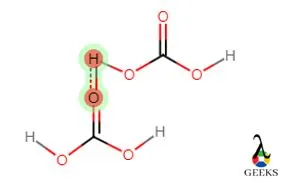Barium carbonate belongs to the class of alkaline earth metal carbonates that can react with powerful acids such as sulfuric acid. Let us look into their reaction in depth.
Sulfuric acid (H2SO4) is a strong, colorless, hygroscopic mineral acid which, when reacted with barium carbonate (BaCO3), a white solid compound, generates a white crystalline metal sulfate. BaCO3 is an odorless noxious chemical that is immiscible in water but miscible in most acids.
Let us discuss the chemical and physical characteristics of the reaction between H2SO4 and BaCO3, such as the products formed, reaction enthalpy, ionic equation, etc.
What is the product of H2SO4 and BaCO3
Barium sulfate and carbonic acid are formed as products when barium carbonate combines with sulfuric acid. The bicarbonate, H2CO3, dissociates instantly into water and carbon dioxide.
BaCO3 (s) + H2SO4 (aq) —> BaSO4 (s) + H2CO3 (aq)
What type of reaction is H2SO4 + BaCO3
H2SO4 + BaCO3 is a double displacement type of reaction, also known as salt metathesis reaction.
How to balance H2SO4 + BaCO3
Following are the steps to balance the reaction mentioned below as per the law of conservation of mass:
BaCO3 + H2SO4 —> BaSO4 + H2CO3
- The number of moles of atoms of each reacting element is counted and tabulated.
| Atoms | Reactant Side | Product Side |
|---|---|---|
| Barium | 1 | 1 |
| Carbon | 1 | 1 |
| Sulfur | 1 | 1 |
| Oxygen | 7 | 7 |
| Hydrogen | 2 | 2 |
- Firstly, the main group elements, in this case, Ba, S and C, are equalized on both the reactant and product sides.
- Lastly, the oxygen and hydrogen atoms are balanced.
- The above reaction is already balanced because of the equal number of atoms of each element present on both the reactant and product sides.
- Thus the balanced chemical equation for H2SO4 + BaCO3 is given below.
- BaCO3 + H2SO4 —> BaSO4 + H2CO3
H2SO4 + BaCO3 Titration
Titration between BaCO3 and H2SO4 will not proceed even though H2SO4 is a strong acid, but BaCO3 does not behave as a base in the reaction.
H2SO4 + BaCO3 Net Ionic Equation
The net ionic equation of H2SO4 + BaCO3 is: BaCO3 (s) + 2H+ (aq) + SO42- (aq) = BaSO4 (s) + 2H+ (aq) + CO32- (aq)
Steps to derive the net ionic equation are as follows:
- The balanced equation is noted considering the phase of each compound.
- BaCO3 (s) + H2SO4 (aq) = BaSO4 (s) + H2CO3 (aq)
- The reacting compounds existing in the aqueous phase and that can dissociate in water are split into their respective ions.
- Finally, the spectator ions, if any, are eliminated to achieve the net ionic equation.
- The net ionic equation is,
- BaCO3 (s) + 2H+ (aq) + SO42- (aq) = BaSO4 (s) + 2H+ (aq) + CO32- (aq)
H2SO4 + BaCO3 Conjugate Pairs
H2SO4 + BaCO3 has the following conjugate pairs:
- Conjugate base of H2SO4 is HSO4–
- Conjugate base of H2CO3 is HCO3–
H2SO4 + BaCO3 Intermolecular Forces
- Van der Waals dispersion forces, hydrogen bonding and dipole-dipole interactions are the intermolecular forces that hold the H2SO4 molecules together.
- Strong electrostatic ionic forces of attraction exist between Ba2+ and CO32- ions as, BaCO3 is an ionic compound.
- Intermolecular forces between H2CO3 molecules are London dispersion forces, dipole-dipole forces, and hydrogen bonding forces.

H2SO4 + BaCO3 Reaction Enthalpy
The reaction enthalpy of H2SO4 + BaCO3 is 47.11 kJ/mol (approximate value).
| Compounds | Moles | Enthalpy of Formation, ΔH⁰f (kJ/mol) |
|---|---|---|
| H2SO4 (aq) | 1 | -909.27 |
| BaCO3 (s) | 1 | -1216 |
| BaSO4 (s) | 1 | -1465.2 |
| H2CO3 (aq) | 1 | -612.96 |
- The enthalpy of a reaction is calculated using the formula: ΔH⁰f (reaction) = ΣΔH⁰f (products) – ΣΔH⁰f (reactants)
- Standard enthalpy of reaction = [1×(-1465.2) + 1×(-612.96)] – [1×(-1216) + 1×(-909.27)] kJ/mol = 47.11 kJ/mol.
Is H2SO4 + BaCO3 a Buffer Solution
BaCO3 and H2SO4 will not produce a buffer solution due to the presence of strong acid, H2SO4.
Is H2SO4 + BaCO3 a Complete Reaction
The reaction BaCO3 + H2SO4 is not a complete reaction as it does not reach completion. This is because a BaSO4 layer forms on the surface of BaCO3 which separates the two reactants. Thus, the reaction ends soon after it begins, since H2SO4 is now no longer in contact with BaCO3.
Is H2SO4 + BaCO3 an Exothermic or Endothermic Reaction
H2SO4 + BaCO3 is an endothermic reaction, as the standard enthalpy of the reaction is positive; thus, energy is provided or absorbed by the system to drive the reaction in the forward direction.
Is H2SO4 + BaCO3 a Redox Reaction
H2SO4 + BaCO3 is not a redox reaction since the oxidation states of the reacting elements do not change on both sides of the reaction.
Is H2SO4 + BaCO3 a Precipitation Reaction
H2SO4 + BaCO3 is a precipitation reaction as the product obtained is a white insoluble precipitate of BaSO4.
Is H2SO4 + BaCO3 Reversible or Irreversible Reaction
H2SO4 + BaCO3 is an irreversible reaction because BaSO4 formed is a residue that is immiscible in water, and as a result, no reverse reaction is possible.
Is H2SO4 + BaCO3 Displacement Reaction
H2SO4 + BaCO3 is an example of double displacement reaction since the cations and anions interchange their positions to form the corresponding products.

Conclusion
Barium sulfate, found in nature as a mineral barite, is a white crystalline solid synthesized by the reaction of BaCO3 with H2SO4. Barium sulfate is a key ingredient in oil well drilling fluid. It works well as a filler in plastics as well. It also demonstrates applicability in the medical field.

Hello, I am Padmakshi Kotoky working as a Subject Matter Expert on this platform. I have completed my post-graduation from the Institute of Chemical Technology, Mumbai. I have always found Chemistry an intriguing subject and enjoy exploring more on it. I would like to utilize this platform to explain the subject in an easy and precise manner making it simpler for the readers to understand the concepts with clarity. I engage myself in Singing, Dancing, and nature photography during my leisure time.
Let’s connect through LinkedIn – https://www.linkedin.com/in/padmakshi-k-b54679132